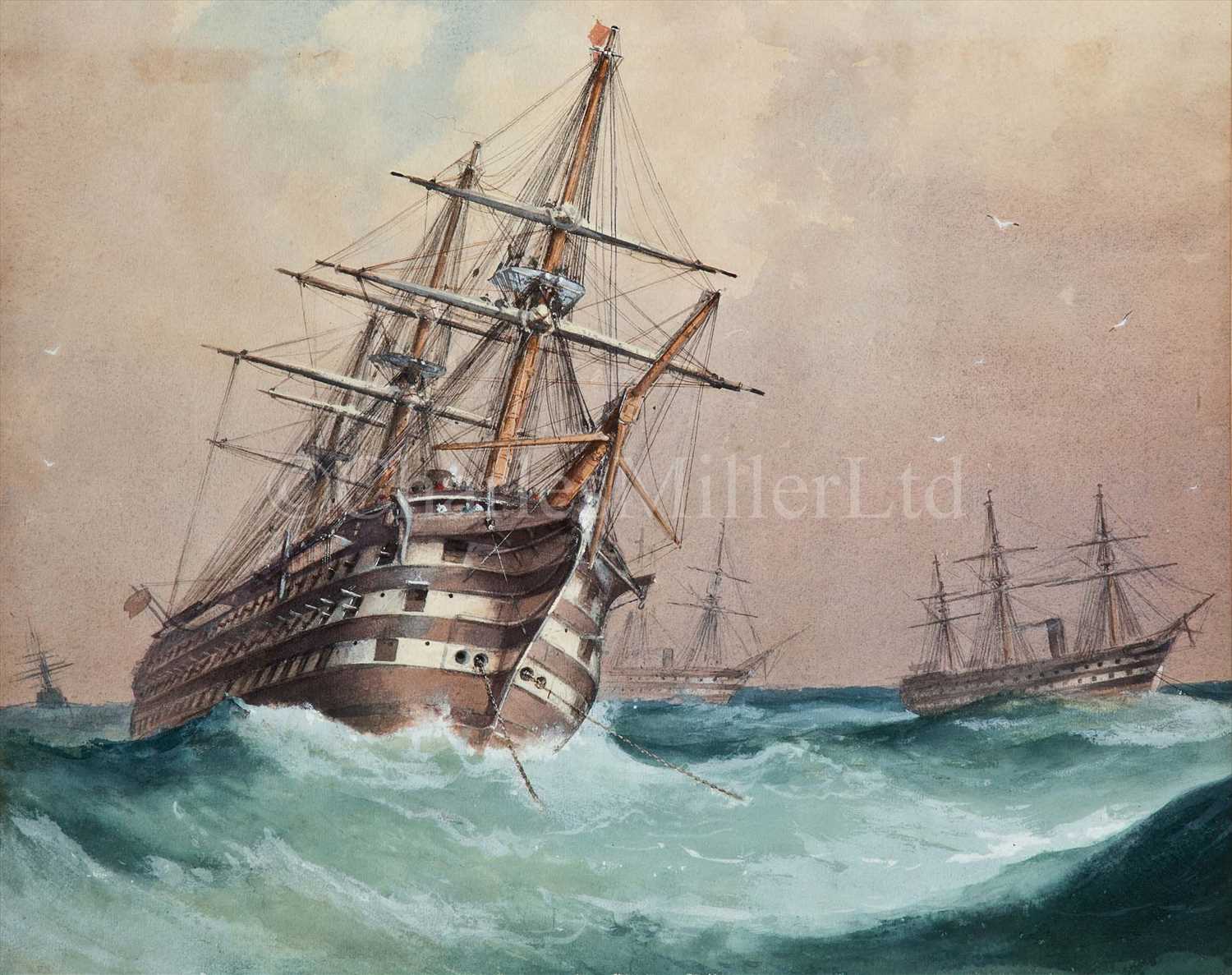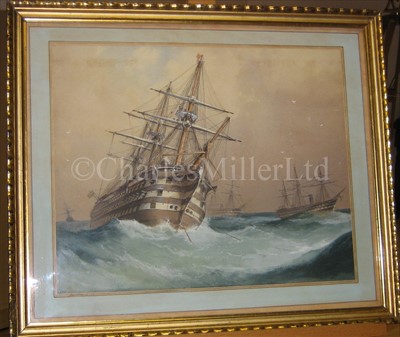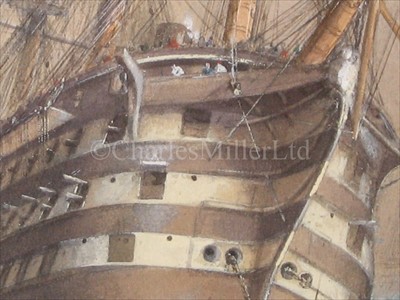25th Apr, 2012 12:00
Maritime and Scientific Models, Instruments & Art (Anzac)
8
[M] FOLLOWER OF THOMAS SEWELL ROBINS <br/>'The First...
'The First Rate Duke of Wellington at anchor in a heavy swell'
Watercolour and gouache
16 x 19¾in. (40.5 x 50cm.)
Built at Pembroke Dock and converted for screw propulsion whilst still on the stocks, she was launched on 14th September 1852, the day of the Duke of Wellington's death, and thus renamed in his honour two weeks later. A splendid 1st Rate measured at 3,759 tons (5,829 tons displacement), she was 240 feet in length with a 60 foot beam and 131 mounted guns of varying calibre, including 30-8in. on her gundeck and 30-32 pdrs on each of her other two decks. For her auxiliary power, she was fitted with a 700nhp. engine by Napier -- removed from the iron-screw frigate Simoom when she was converted into a troopship in April 1852 - which, on her trials in April 1853, gave her a very satisfactory cruising speed of 10.15 knots.
Sent to the Baltic as flagship to Admiral Sir Charles Napier's fleet for the campaign against the Russians in 1854-55, she was widely admired both for her sailing as well as her steaming qualities, although her sea-going career proved a short one, apparently, due to the age of her secondhand machinery and the indecent haste of her conversion to steam as she approached completion. After a brief spell in the Mediterranean as Second Flagship in 1856, she came home to be paid off and was then placed in reserve until 1863 when she became a receiving ship at Portsmouth. This last role proved a lengthy one and, for nearly forty years, she remained a familiar sight at her permanent mooring in the harbour there until she was sold in 1902 and finally broken up in 1909.
Sold for £372
Estimated at £200 - £400
(inc. buyer's premium of 24%)
Condition Report
Some darkening to sky probably caused by earlier mount; lower margin has some minor mount abrasions. No evidence of restoration, unexamined out of frame.
We are pleased to provide you with a general report of the condition of this property. Since we are not professional conservators or restorers, we urge you to consult with a restorer or conservator of your choice who will be better able to provide a detailed, professional report. Prospective buyers should inspect each lot to satisfy themselves as to condition and must understand that any statement made by Charles Miller Ltd is merely a subjective, qualified opinion. Prospective buyers should also refer to any Important Notices regarding this sale, which are printed in the Sale Catalogue. NOTWITHSTANDING THIS REPORT OR ANY DISCUSSIONS CONCERNING A LOT, ALL LOTS ARE OFFERED AND SOLD “AS IS” IN ACCORDANCE WITH THE CONDITIONS OF BUSINESS PRINTED IN THE SALE CATALOGUE.
'The First Rate Duke of Wellington at anchor in a heavy swell'
Watercolour and gouache
16 x 19¾in. (40.5 x 50cm.)
Built at Pembroke Dock and converted for screw propulsion whilst still on the stocks, she was launched on 14th September 1852, the day of the Duke of Wellington's death, and thus renamed in his honour two weeks later. A splendid 1st Rate measured at 3,759 tons (5,829 tons displacement), she was 240 feet in length with a 60 foot beam and 131 mounted guns of varying calibre, including 30-8in. on her gundeck and 30-32 pdrs on each of her other two decks. For her auxiliary power, she was fitted with a 700nhp. engine by Napier -- removed from the iron-screw frigate Simoom when she was converted into a troopship in April 1852 - which, on her trials in April 1853, gave her a very satisfactory cruising speed of 10.15 knots.
Sent to the Baltic as flagship to Admiral Sir Charles Napier's fleet for the campaign against the Russians in 1854-55, she was widely admired both for her sailing as well as her steaming qualities, although her sea-going career proved a short one, apparently, due to the age of her secondhand machinery and the indecent haste of her conversion to steam as she approached completion. After a brief spell in the Mediterranean as Second Flagship in 1856, she came home to be paid off and was then placed in reserve until 1863 when she became a receiving ship at Portsmouth. This last role proved a lengthy one and, for nearly forty years, she remained a familiar sight at her permanent mooring in the harbour there until she was sold in 1902 and finally broken up in 1909.
Auction: Maritime and Scientific Models, Instruments & Art (Anzac), 25th Apr, 2012



